

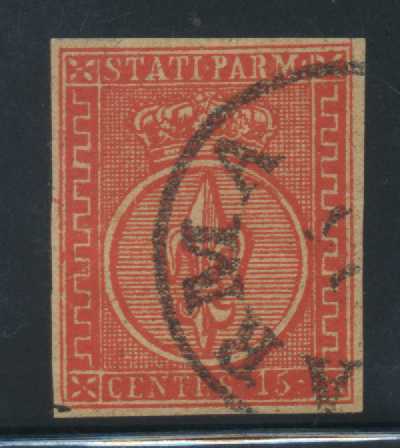



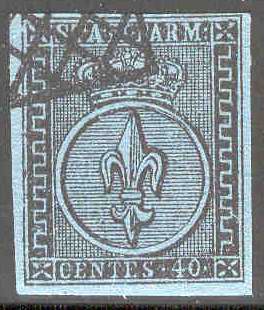
Return To Catalogue -Parma 1852 issue - Parma 1857 issue - Parma 1859 issue, part 1 - Parma 1859 issue, part 2 - Italy
Note: on my website many of the
pictures can not be seen! They are of course present in the cd's;
contact me if you want to purchase them: evert@klaseboer.com.
Currency: 1 Lira = 100 Centesimi
The above forgeries have two dots behind 'PARM' as a ':'. This is probably a Spiro forgery (Filatelie Informatief May 1985 p 7010-3). The cross on top of the crown is almost below the 'I' of 'STATI'. The white circle is nearer to the left hand side frame than to the right hand side frame. The top of the fleur-de-lis is touching the circle above it (in the genuine stamps it does not touch). The lines behind the fleur-de-lis are much less coarse than in the genuine stamps. The cancels are circular or as on the last two stamps (about the size of the stamp, a similar real cancel exists, but about 1/4 size of the stamp). This is the first forgery described in 'Album Weeds' and it is also described in 'The Spud Papers'. There are much less lines in the circle than in a genuine stamp.



These forgeries with 'FAUX' overprint, as they can be found in
'The Fournier Album of Philatelic Forgeries'

Page of a 'Fournier Album of Philatelic Forgeries' showing the
second choice forgeries on the top row and a block with better 40
c forgeries (see under 'Fourniers' first choice forgeries'.

Another page from a Fournier Album.
Fournier also offers the above forgeries in his 1914 pricelist for 1.50 Swiss Francs (he offers 6 values as second choice forgeries). It should be noted that Fournier also offered first choice forgeries of this issue (see later)
I think the above stamps must be the second
forgery described in the book Album Weeds. There
is only 1 line of shading between the circle and the top of the
fleur de lys symbol (should be 2). The cross on top of the crown
is nearer to the 'I' than to the 'P' (it should be exactly in the
middle). The background behind the crown looks different than the
originals (should be regular fine points). There should be 4
pearls in each of the outer arches of the crown (the above stamp
has 5 ) and 3 in the inner arches (the above stamp has 4). The
dot between 'STATI' and 'PARM' is more like a '-'. Note also the
thick line between the circle and the crown (in the genuine
stamps it is much smaller). The left side ornamenal border only
has 7 1/2 elements, in the genuine stamp, there are 8 1/2
elements (this is an easy test). The cancel of the 15 c red
forgery doesn't correspond to the genuine cancels used in Parma.
I've also seen a 15 c red of this set of forgeries, with part of
a circular cancel and additionally a 'FRANCO' in a box cancel.

The above forgery of the 40 c has lines as a background behind the crown, it should be small dots! I think the 15 c and 25 c values are made by the same forger, but I cannot distinguish the design. The 'C' of 'CENTES' is placed too close to the white line to the left of it. The 'S' of 'STATI' is slanting forwards. The block of four 15 c stamps might also have been made by the same forger; note that the impression is now very blotchy.


'PAPM' instead of 'PARM' forgeries.
In the above forgery of the 40 c the 'A' of 'STATI' is too broad and the value '40' doesn't resemble the genuine stamp. Furthermore there is no cross on top of the crown, instead there is a pearl. The bogus 10 c red was probably issued by the same forger. The inscription on top appears to be 'STATI PAPM'. I've also seen the 10 c in the bogus color green.


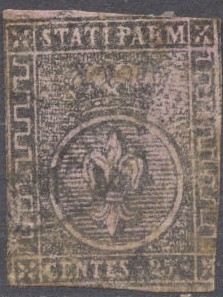



(left and right frame ornaments are different from the genuine
stamps)
In the above forgeries the ornaments (Etruscian pattern) are different in the left and right frames. Also the circle does not touch the side frames. It is very blotched, I think this is the fourth forgery described in Album Weeds. The 5 c orange forgery above seems to have a 'K.K. ZEITUNGS' cancel? I've also seen the 40 c black on blue of this particular forgery set. The 'S' in 'STATI' is too small.



Forgeries with a straight 'FRANKO' (with 'K'! possibly also with
'C') cancel.

(Reduced size)
Another forgery with wrong side ornaments is shown above, this is especially clear in the left bottom corner, the Etruscian pattern stops at the left hand side (in the genuine stamps it stops at the right hand side). I've seen it only this bogus 'FRANKO'/ 'FRANCO'?). The value 15 c red and 15 c black also exists of this particular set. I've seen these forgeries on a sheet with the text 'H.Hänsler Zürich' (possibly the maker or seller of these forgeries?).

(Reduced size)

The above forgeries have the side ornaments different, there are only 5 turns of the Etruscian pattern on each side.
It should be noted that Fournier also offered first choice forgeries of this issue; 3 values, a 40 c black on blue, 5 c yellow and another value (probably the 10 c value). They were offered for 1 Swiss Franc in his 1914 pricelist. Among them there are tete-beche forgeries of the 40 c value (only the 15 c is genuinely known in tete-beche).
I suspect that the above 40 c stamps are such Fournier forgeries. In my opinion, the '4' should be open instead of closed. The background behind the crown is quite defective. There are some very characteristic vertical lines in the background just above the central circle in the 40 c value. I think this is the forgery described in the Serrane Guide; the 'P' of 'PARM' is connected by a line to the frameline above it. In the 'Fournier Album of Philatelic Forgeries' I have seen a 5 c value with 'BORGO 6 FEBR 59' cancel as in one of the above forgeries. However, the 5 c seems to be a quite different forgery (it doesn't have the same distinghuishing characteristics). The above shown 'PD' cancels are not shown in the Fournier Album (though similar 'PD' cancels from Switzerland were forged by Fournier). A whole sheet of these forgeries can be found above on a page of the 'Fournier Album'. These forgeries are often offered as genuine.

Page of a 'Fournier Album of Philatelic Forgeries' with some
forgeries of the Papal States and the 'BORGO 6 FEBR 59' forged
cancel

10 c Fournier forgery as taken from a Fournier Album.
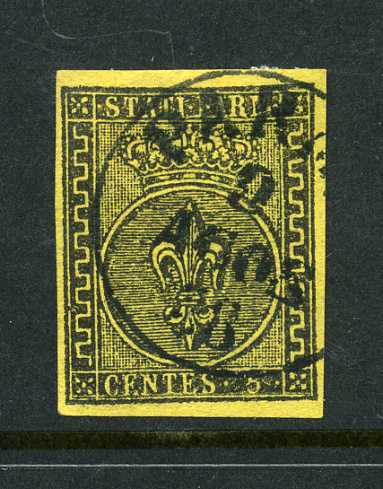


Possibly Fournier forgeries as well with the cancel 'PARMA 9 AGOS
58' as can be found in 'The Fournier Album of Philatelic
Forgeries'

Page from 'A Fournier Album' with an example of the forged cancel
cancel 'PARMA 9 AGOS 58'
Another Fournier forgery that can be found in 'The Fournier Album of Philatelic Forgeries' is the 5 c yellow value with cancel 'BORGO 6 FEBR 59' in a single circle. A small image of such a stamp can be found on the page with Fournier forgeries under 'first forgeries'.
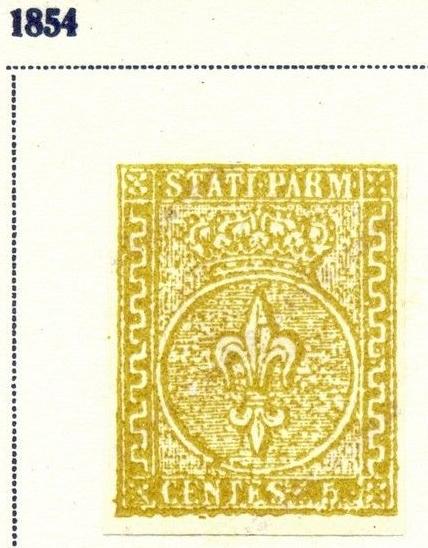
5 c yellow Fournier forgery as taken from a Fournier Album.
Senf made a forgery of the 5 c yellow stamp (also orange?). This forgery was distributed with stamp journal the 'Illustrierten Briefmarken Journal', No 14 (16 July 1887) as an 'art supplement' or 'Kunstbeigabe'. The forgery always bears the word 'Facsimile' on top. The second image shows a stamp with the word 'Facsimile' first having been partly erased and then a 'cancel' was applied to the area to hide that word.

I've been told that this tete-beche 15 c pair is a Sperati
forgery

A forgery of the 15 c with inscription 'CENTS' instead of
'CENTES', reduced size

Forgery with 'CENTES' too far to the right.

Forgery with very thin lettering.
Modern forgeries:

Reduced sizes

Reduced sizes
The above modern forgeries of the 5 c yellow, 15 c red and 25 c brown are offered in large quantities on Ebay (2005). Note the extremely large margins around the stamps. They are often offered together with other Italian States modern forgeries. All three values have the same defects, for example a dot in the white line below the 'M' of 'PARM'.
Album Weeds lists a further three more types of forgeries, besides the ones shown here.
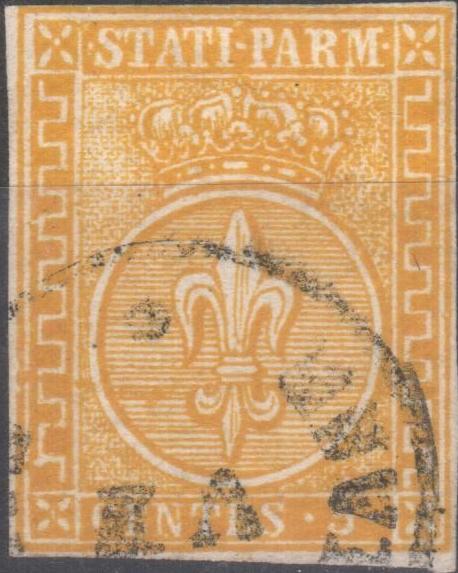


Other forgeries of the 5 c yellow and 15 c red stamps. There is a
wide space between the inner circle and the left hand border.
Furthermore, the background behind the circle consists of small
irregular dots. The bogus 'VF' cancel can also be found on many other forgeries
For Parma 1857 issue, click here, and for Parma 1859 issue, click here.